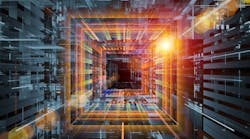If you are like me, at some point, you have had a “Microsoft moment” and lost some important document or file on your computer because—in spite of all the warnings—your computer was not backed up properly. Regardless, many of us now have external hard drives and/or some sort of cloud backup.
Until only a few years ago, a lot of us had never heard of cloud computing, and now it is part of our everyday vernacular. While we talk a lot about the carbon footprint associated with HVAC systems and equipment, have you ever thought about the carbon emissions associated with cloud computing? According to IEEE, in 2012, Facebook’s data centers had greenhouse-gas emissions (GHG) of nearly 300,000 mtCO2e—equivalent to almost one-third of the cars on I-595 (greater Fort Lauderdale, Fla.) at rush hour! There are, of course, ways to reduce cloud computing’s GHG emissions, but those generally involve increased cost and reduced speed. It is somewhat like the tradeoffs we see in our industry: We can reduce the GHG emissions of our HVAC systems, but it generally comes with a price, as higher energy-efficiency-ratio/seasonal-energy-efficiency-ratio/coefficient-of-performance values generally translate to higher first costs (although, depending on the energy rated, the operating costs may be significantly lower).
It is interesting to note the similarities between computing and HVAC. The scientists who are modeling data-center emissions are using algorithms to optimize three key variables: dollars per kilowatt-hour, speed, and bandwidth. Compare that to an engineer optimizing a chiller plant in order to reduce kilowatts per ton (thus, reducing total electric-energy cost). She/he employs similar algorithms for functions ranging from basic compressor runtime control, to chilled-water-supply-temperature control, to condenser-water reset, to—in some cases—very sophisticated adaptive control that optimizes the entire system: chillers, pumps, and cooling-tower fan motors. Also, there is a direct relationship between data-center and HVAC-system emissions because of the heat load attributable to servers. Obviously, more efficient servers requiring less power generate less heat and require less air-conditioning capacity.
In addition to load balancing, in both computing and HVAC, storage must be optimized, as it also consumes energy. Too little on-site data storage limits request routing between data centers, while too much is expensive (in terms of both time and energy) and environmentally unfriendly—just as a too small or inadequately insulated hot- or chilled-water storage tank requires more energy and results in higher GHG emissions, while an oversized tank is expensive in terms of first cost, energy consumption, and real-estate utilization.
Once again, it’s a balancing act between greener and cheaper, something we’re very much used to seeing in our industry.









